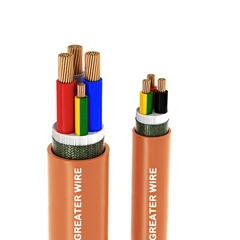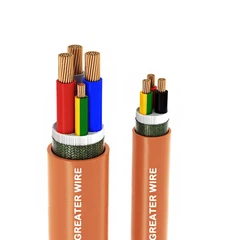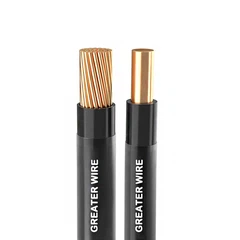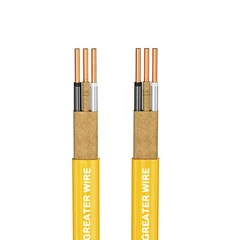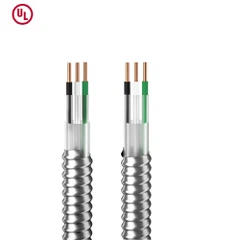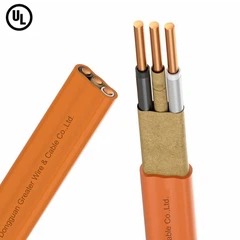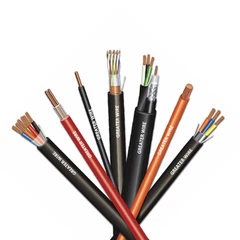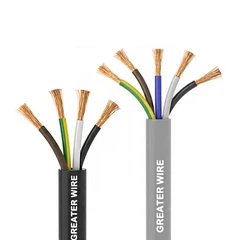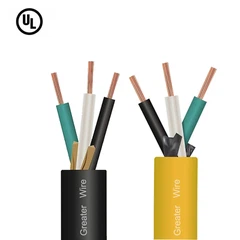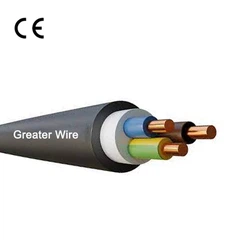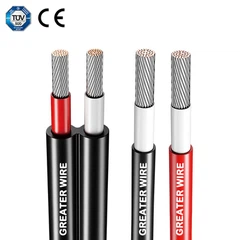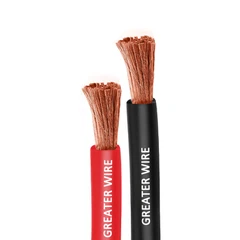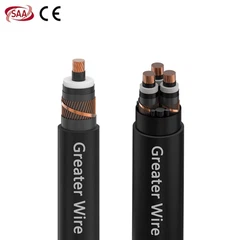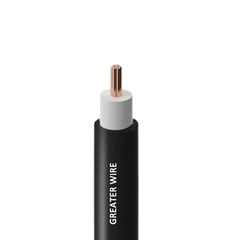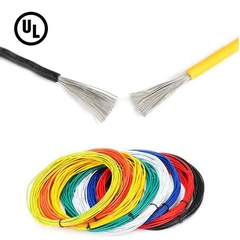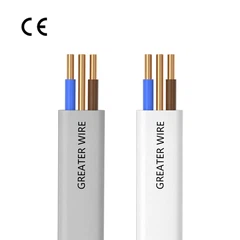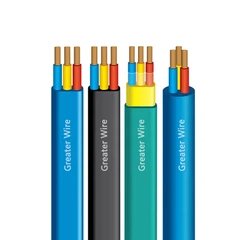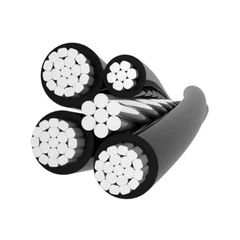When planning residential electrical installations, one of the most common questions electricians and homeowners ask is whether NM Cable (Non-Metallic Sheathed Cable) can be used as a Service Entrance (SE) Cable. Because both are widely applied in residential wiring, there is often confusion about their roles, capabilities, and limitations. Choosing the wrong type of cable not only risks electrical code violations but also creates safety hazards such as overheating, premature cable failure, and even fire risks.
In this article, we will clarify the difference between NM Cable and Service Entrance Cable, explain why NM cannot serve as a service entrance, and provide practical guidance on how to select the correct type of cable for your project.
What is NM Cable?
NM Cable, commonly known as NM-B, stands for Non-Metallic Sheathed Cable. It is one of the most widely used electrical wires for indoor residential wiring in the United States.
- Structure: NM-B consists of two or more insulated conductors plus a bare ground wire, all enclosed in a PVC non-metallic outer jacket.
- Rating: Rated at 90°C (194°F) for conductors, though limited by NEC to 60°C (140°F) ampacity in most residential branch circuits.
- Typical Use: Dry, indoor locations such as inside walls, ceilings, and floors. It is commonly used for lighting, receptacle circuits, and general household wiring.
In short, NM-B Cable is the go-to choice for indoor branch circuit wiring, but it is not designed for outdoor or service entrance use.

What is Service Entrance (SE) Cable?
Service Entrance Cable, abbreviated as SE Cable, is specifically designed for carrying power from the utility service point (meter) into the main distribution panel of a building.
1.Structure: SE Cable has conductors with thermoplastic insulation and a more robust outer jacket designed to resist sunlight, moisture, and mechanical stress.
2.Types:
- SE-R Cable: Multiple insulated conductors plus a bare neutral, typically used for above-ground service entrance and feeder applications.
- SE-U Cable: Two insulated conductors and a bare neutral conductor, often used for single-phase service.
3.Application: Outdoor use is permitted, and SE Cable is specifically listed for service entrance applications by the NEC.
This makes SE Cable the correct and compliant choice for service entrance wiring, not NM Cable.
Key Differences Between NM Cable and SE Cable
| Feature | NM Cable (NM-B) | SE Cable |
|---|---|---|
| Outer Jacket | PVC non-metallic, not UV-resistant | Sunlight-resistant, weather-resistant |
| Environment | Indoor dry locations only | Indoor and outdoor use, including above ground |
| Temperature Rating | 90°C (limited by NEC to 60°C ampacity) | 90°C or higher depending on insulation |
| NEC Approval for Service Entrance | ❌ Not approved | ✅ Specifically approved |
| Common Use | Branch circuits for outlets and lights | Service entrance from meter to panel |
From this comparison, it becomes clear: NM Cable is not suitable for service entrance applications.
Why Can't NM Cable Be Used as Service Entrance Cable?
There are three primary reasons NM Cable cannot be used as SE Cable:
1.Lack of Sunlight Resistance – NM Cable jackets degrade quickly under UV exposure. Prolonged outdoor use will cause cracks and insulation breakdown.
2.Moisture Exposure – NM Cable is not rated for damp or wet locations. Outdoor service entrances inevitably face rain and condensation.
3.Code Restrictions – The National Electrical Code (NEC) prohibits NM Cable in outdoor or service entrance applications. Using it in these ways results in non-compliance and safety violations.
Thus, even if NM Cable is more affordable and commonly available, it should never be substituted for SE Cable in service entrance installations.
Common Ground: NM Cable and SE Cable
Despite their differences, NM and SE Cables do share some characteristics:
- Both use copper conductors for high conductivity.
- Both are UL Listed, ensuring compliance with U.S. safety standards.
- Both are commonly used in residential electrical systems, though for different parts of the system.
This is why confusion exists, but careful distinction is necessary to ensure compliance and safety.
Common SE Cable Sizes and Applications
| Size | Ampacity | Typical Use Case |
|---|---|---|
| 6 AWG SE | 55 Amps | Small residential service |
| 4 AWG SE | 70 Amps | Small-to-mid size homes |
| 2 AWG SE | 100 Amps | Standard residential main service |
| 1/0 AWG SE | 150 Amps | Larger homes |
| 4/0 AWG SE | 200 Amps+ | Large homes or multi-unit residences |
When selecting SE Cable, the correct size depends on the amperage rating of the service panel and the overall load of the building.
Can NM Cable Be Used as Service Entrance Cable?
The short and clear answer is: No, NM Cable cannot be used as Service Entrance Cable.
- NM Cable: Only suitable for indoor dry locations such as branch circuits.
- SE Cable: Specifically designed and listed for outdoor and service entrance use.
If you need to run wiring from the meter to your main service panel, SE Cable (SE-R or SE-U) is the NEC-compliant and safe choice.
How to Choose the Right Cable Model
Selecting the correct cable depends on location, amperage, and application:
- Indoor circuits → Use NM-B Cable (e.g., 14/2 for lighting, 12/2 for kitchen outlets).
- Service Entrance (100A) → Use 2 AWG SE Cable.
- Service Entrance (200A for large homes) → Use 4/0 SE Cable.
- Underground service → Use USE-2 or URD Cable.
📌 Example:
- For a small apartment, you may use NM-B 14/2 for lights and outlets, while the main service requires SE 2 AWG.
- For a luxury villa requiring a 200A panel, the correct choice is SE 4/0 AWG for the service entrance, while indoor circuits still use NM-B.
This demonstrates that different cables serve different roles, and trying to replace SE with NM would compromise safety and code compliance.
Conclusion and Professional Recommendation
To summarize: NM Cable cannot be used as Service Entrance Cable. Each has its specific purpose - NM-B for indoor branch circuits, SE for outdoor service entrances. Choosing the correct cable ensures compliance with NEC, protects your property, and guarantees long-term reliability.
When planning your project, always:
Verify the NEC code requirements.
Select the proper cable type based on location and amperage.
Consult with a professional supplier to ensure compatibility.
please select Greater Wire & Cable
At Dongguan Greater Wire & Cable Co., Ltd., we understand that selecting the right cable is critical for both safety and efficiency. That's why we provide a full range of NM-B, SE, UF-B, THHN, and XHHW Cables that meet both UL and cUL certifications.
- Comprehensive Product Range: From 14/2 NM-B to 4/0 SE, we offer every size you need for both small and large-scale projects.
- International Standards: All our products comply with UL and cUL standards, ensuring they meet U.S. and Canadian market requirements.
- Reliable Supply Chain: We serve distributors, contractors, and project developers worldwide, ensuring timely delivery.
- Expert Support: Our technical team provides professional consultation, helping you select the right cable for your project.
- Customer Commitment: Whether your project is a single-family home or a multi-unit development, we deliver dedicated pre-sales and after-sales support.
👉 For professional cable solutions tailored to your needs, contact us today:
Dongguan Greater Wire & Cable Co., Ltd.
Tel/WhatsApp/Wechat: +86 135 1078 4550 / +86 136 6257 9592
Email: manager01@greaterwire.com

